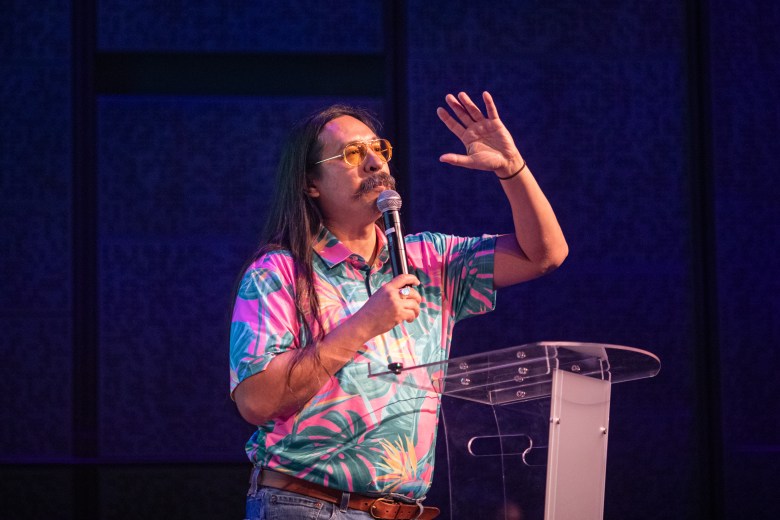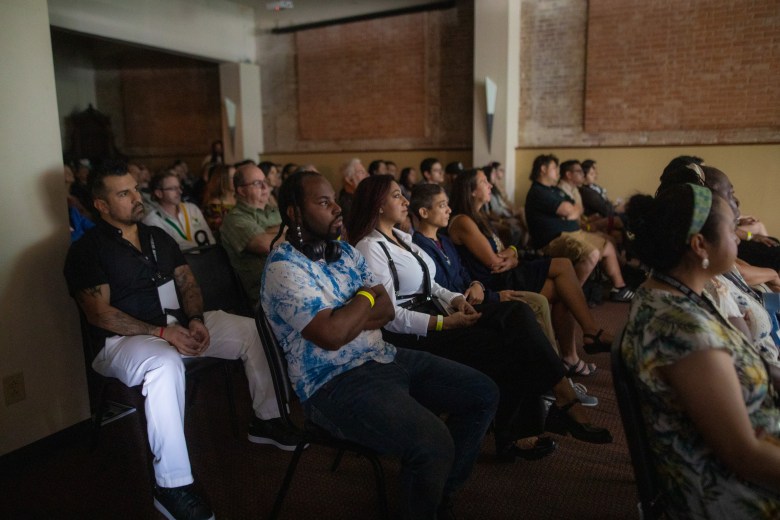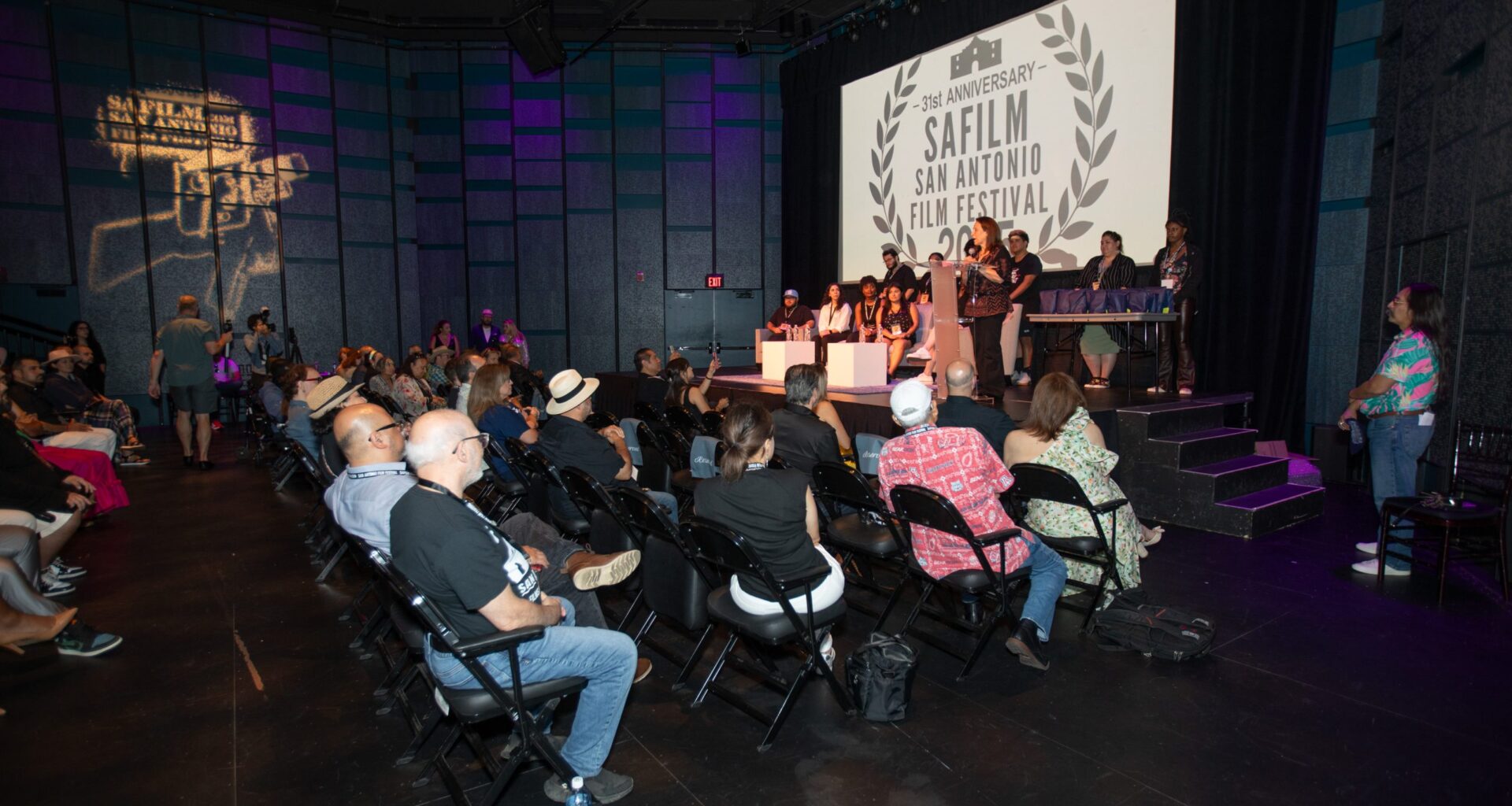Dozens of eyes looked up at a shimmering screen at the Radius Center in downtown San Antonio, drinking in a series of short films. The room is full, more onlookers stand at the back, and the crowd cheers whenever one of the films ends and the credits roll.
This same scene played out at downtown theater locations over the course of six days for the 31st San Antonio Film Festival, which concluded on Sunday.
Filmmakers, from local to global, submitted hundreds of films and festival organizers showcased a variety of genres and styles just as San Antonio and Texas are pushing to grow the film industry in the region.
“When you see it on the big screen, it’s both the fruits of your labor and your final test,” said Lonnie Smith, a San Antonio-based filmmaker who worked on the short film, “The Devil and the Sea.”
It’s an opportunity for local filmmakers to put their movie into the public eye and to connect with others. But it’s also big business.
The Texas Senate approved hundreds of millions of dollars in incentives for film productions to come here. And Adam Rocha, one of the film festival’s longtime organizers and leaders, says he hopes the money will help keep talented filmmakers and workers in town.
 Adam Rocha, founder of SA Film Festival, greets attendees of the award ceremony for the festival at the Carlos Alvarez Studio Theater. Credit: Vincent Reyna for the San Antonio Report
Adam Rocha, founder of SA Film Festival, greets attendees of the award ceremony for the festival at the Carlos Alvarez Studio Theater. Credit: Vincent Reyna for the San Antonio Report
Robert Cantu, who directed the short film “Toxic Abuse,” said part of his goal is getting the movie out there to be shown.
“It’s why we make these films,” Cantu said. “You don’t make the film and put it away.”
Rocha said the event gives local filmmakers a chance to connect with each other and share a creative space. It allowed people to access and learn about filmmaking resources, along with showing their movies.
For Smith, that means getting outside his comfort zone and sharing his work with others. He’s happy to do it closer to home, though.
“What better place than here?” he said.
Lennon Maldonado has been volunteering at the festival since 2010. He helps organize the films and figure out how and when they’ll be shown, so he sees many of the hundreds of submissions.
The film festival does not actively pursue showing local films, he said, but the quality of local movies by directors like Cantu and Smith has grown immensely after a pandemic-era lull.
“The post-COVID slump is over,” Maldonado said. “They’re full-on mature artistic voices.”
Maldonado said the film festival takes 10 months to put together. Organizers draw on a diverse group of screeners and judges, from inside and outside the film industry, to select movies. They try to choose a mix of films based on their impact on viewers and the strength of the director’s voice.
“It’s more about the genre and vibes you’re going for,” he said, adding that “it’s definitely getting easier to include (local films). The quality is going up.”
Growing an industry in Texas
The film festival took place months after Texas lawmakers approved a massive investment into the film industry. Senate Bill 22 promises to put $500 million into a Texas Moving Image Industry Incentive Fund every other year through 2035.
The Texas Film Commission, a part of the governor’s office, oversees the money through “a competitive program that provides eligible productions the opportunity to receive a cash grant based on a percentage of a project’s eligible Texas expenditures, including eligible wages paid to Texas residents,” said the commission’s director, Stephanie Whallon, in an email.
That funding got attention from festival attendees. Rocha said the amount of money on the table was both a surprise and potential benefit. He’s been involved in San Antonio’s film industry for decades.
“We don’t have to brain drain, they don’t have to leave the city,” Rocha said. “All these people have a passion for storytelling.”
Financing can affect films, particularly for independent filmmakers carving their own way in the industry.
Cantu tries to craft unique film noirs and prides himself on shooting onsite. His films are self-financed, so he seeks locations that are affordable and crews invested in the creative vision.
“I write a script and then I go out and find something within my budget,” he said.
 SA Film Festival attendees watch a selection of short films entered into the festival at Radius Center. Credit: Vincent Reyna for the San Antonio Report
SA Film Festival attendees watch a selection of short films entered into the festival at Radius Center. Credit: Vincent Reyna for the San Antonio Report
Cantu said he’s not thinking about the potential state funding, but noted that more local productions create more networks and connections amongst filmmakers.
Baylor Jones, who worked with Smith on “The Devil and the Sea,” said financing can impact where they can make movies and the spaces that are friendly to independent filmmakers. He hopes to see the new state funding help independent filmmakers, not just large production companies and expensive movies that come to the state to shoot.
State officials plan to use the funding broadly, said Whallon.
“The Texas Film Commission welcomes all types of productions, supporting local filmmakers, as well as welcoming on-location filming from other jurisdictions. All production is vital to maintaining a balanced production ecosystem,” she said.
Growing film and media industries, from movies to television shows to video games has an economic impact in the short run — with more local spending and jobs — and long-term benefits like tourism, Whallon said.
The commission offers tax credits, online job and production directories and other incentives for movie makers.
The City of San Antonio doubled-down on those incentives, trying to take in even more of the filmmaking business, which is usually centered in Austin and in Fort Worth.
A June press release noted that the city has its own 7.5% rebate on local expenditures, creating a combined 38.5% rebate package between state and city incentives when movies film in San Antonio and are able to submit qualifying expenses.
What does that mean for San Antonio’s film industry?
Some local business owners are excited about the possibilities, including larger productions. Michael “Doc” Harris is an extra who also runs a film consulting company that provides expertise from military personnel to movies.
If more larger productions are coming to Texas, that opens up opportunities for him, he said.
Jeremy Kenisky and Diego Cantu run Mighty Industries, a film company based in San Antonio. Kenisky also manages Alamo City Studios, which houses and caters to local independent filmmakers.
The pair noted that when more films come to town, the effects ripple out to local technical staff, not just writers, actors and filmmakers. Dozens of people can be involved in building sets, working with sound or cameras and any number of other jobs.
 SA Film Festival interns pose for photos during a screening for short films at the Radius Center. Credit: Vincent Reyna for the San Antonio Report
SA Film Festival interns pose for photos during a screening for short films at the Radius Center. Credit: Vincent Reyna for the San Antonio Report
“The more volume that will come through, the more people will be able to make a living,” Diego Cantu said.
How that happens is still a question. Mighty Industries and Alamo City Studios are, similar to the state, trying to build a robust film ecosystem at the local level by creating networks of local filmmakers.
Kenisky is hopeful that the new funding will support more those artists and workers.
“You don’t want Hollywood flying here, taking up all the tax dollars and flying away,” he said.
Creating that workforce is another challenge, Kenisky said. San Antonio doesn’t have as many film crews ready to work on projects.
Andrea Meral, a San Antonio movie director who works with California-based film company ReelShort, as well as Mighty Industries, said the new funding still feels like a watershed moment for the film industry.
More productions in San Antonio, whether they are local filmmakers or bigger studios from elsewhere, means more local jobs and growing expertise in San Antonio.
“I do see Hollywood coming here because of the incentives,” she said. “I do see an exponential amount of people who are excited to get into film.”
There’s almost a psychological effect, Meral added. It feels like a safety net or encouraging push in an industry that can be tough.
“It’s an incentive to go out and do art,” she said.
